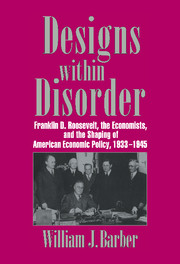 Designs within Disorder
Designs within Disorder Published online by Cambridge University Press: 11 September 2009
When the Agricultural Adjustment Administration was created in May 1933, precisely what this novelty would amount to was not clear. The act conveyed to the Secretary of Agriculture extraordinary powers to raise farm prices. Counsels were divided, however, about the ways they should be exercised. Measures to raise demand (particularly through export promotion) had a formidable political constituency, particularly because their advocates preferred not to tamper with a farmer's decision about what and how much to produce. Techniques to restrict supply enjoyed no comparable popularity among the farm lobbies, though a substantial number of economists concerned with the plight of agriculture held them to be crucial to relief of farm distress. There were, however, two versions of supply management. One insisted that direct controls, via the domestic allotment method for shrinking outputs, were essential, at least in the short term. The other assigned priority to output shrinkage through governmental programs to retire acreages ill suited to tillage.
By the end of 1933, earlier uncertainties about which of the various strategies would take precedence were largely removed. The major in-house voice for market expansion (and ideally without production constraints), George N. Peek, had been replaced as Agricultural Adjustment Administrator by Chester Davis, who was more sympathetic to output controls. At the same time, the ways in which government intervened to reduce supply had given rise to complications that the planners had not anticipated. Nor should this have been a matter of surprise.
To save this book to your Kindle, first ensure no-reply@cambridge.org is added to your Approved Personal Document E-mail List under your Personal Document Settings on the Manage Your Content and Devices page of your Amazon account. Then enter the ‘name’ part of your Kindle email address below. Find out more about saving to your Kindle.
Note you can select to save to either the @free.kindle.com or @kindle.com variations. ‘@free.kindle.com’ emails are free but can only be saved to your device when it is connected to wi-fi. ‘@kindle.com’ emails can be delivered even when you are not connected to wi-fi, but note that service fees apply.
Find out more about the Kindle Personal Document Service.
To save content items to your account, please confirm that you agree to abide by our usage policies. If this is the first time you use this feature, you will be asked to authorise Cambridge Core to connect with your account. Find out more about saving content to Dropbox.
To save content items to your account, please confirm that you agree to abide by our usage policies. If this is the first time you use this feature, you will be asked to authorise Cambridge Core to connect with your account. Find out more about saving content to Google Drive.